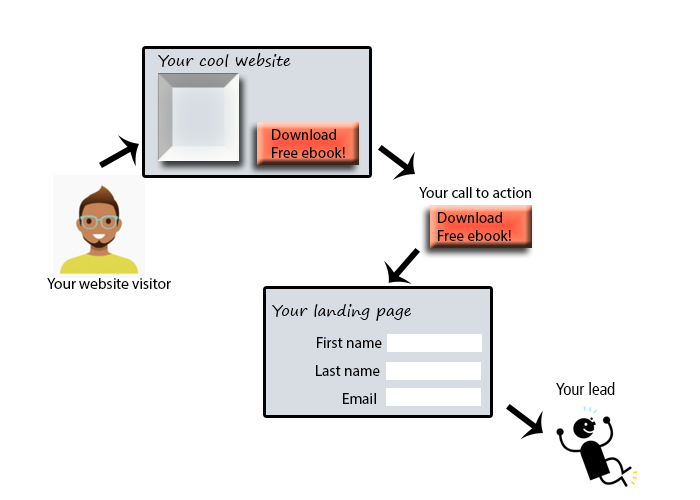Module 1: Readings and Videos Part II

Overview
With the changes in marketing created by technology, the focal point of business marketing has also shifted. Today, a company’s website serves as the hub of their marketing. It is the digital version of their storefront or office. This module, we will explore different frameworks for web design and analyzing websites for effectiveness.
Website Design
Your website is the hub for all your digital marketing. It is the online version of your store, office, or restaurant. This is where people go to learn about you, understand why they should choose you, and make purchases.
Your website should provide more than facts about your company and products. Today, consumers are unimpressed with static, facts-based websites. They do not trust a company whose website looks like it was built in 2000. Your website should be equal parts easy to use, appealing to look at, and full of content and value that your audience can use and enjoy.
People who visit your site should have a reason to keep coming back, whether that is an interesting blog site, an updated news section, or a game they can play every time they come back. However, if you choose to engage your customer, you need to ooze your brand through your website.
Your website is used to:
- Establish credibility
- Increase visibility and reach
- Convey client-focused value
- Provide customer service
- Establish a method of analyzing and measuring online marketing success
Most websites have a simple overall objective, that may include one of the following:
Earn money through online sales (Amazon, Zappos, etc.)
Advertising (Newspapers, BuzzFeed, etc.)
Commissions (StubHub, etc.)
Subscriptions (Netflix, Spotify, etc.)
Provide info to support offline sales (Clorox, Johnson & Johnson, etc.)
Support a cause (Doctors without Borders, Protect Our Winters, ASPCA, etc.)
Provide Customer Support (Microsoft Support, etc.)
In addition to the overall goals, a company may measure a variety of conversions to decide whether its website is effective or not. The following table demonstrates some conversions that may be considered primary or secondary. The primary conversion will be their priority, but secondary conversions are also helpful and bring a visitor closer to a sale.
Design Frameworks
When a company designs a website, it may use one of the following frameworks.
Design for Usability
Think Walmart.com or Amazon.com. A website designed for usability follows traditional website conventions and hierarchies that visitors expect to see. The designers break the website up into clearly defined areas to make navigation simple and obvious. They avoid using flashy videos or movement or anything else that would distract a visitor from finding what they need. 
[Source: Walmart]
Conversion-Centered Design
Think dropbox.com. The design is simple, catches a visitor’s attention. It explains context right off the bat. It is clear and congruent. There is no distraction from the point, which is to convert. In Dropbox’ case, that conversion is to start a free trial. 
[Source: Dropbox]
Three Questions
The three-questions framework answers the following three questions: What are you offering? Why should I pick you? What do you want me to do next? For this framework, consider the doba.com website. Doba simplifies drop shipping for businesses. That is the point of their entire website. Their service, reason to be picked, and next step are all shown in that very first picture (Drop Shipping. Simplified. Instant access to hundreds of dropship suppliers and millions of products in one catalog. Try free for 30 days.) Simple. To the point. Answers any questions that may be holding a visitor back.
[Source: Doba]
Segments
Conversion, or the next step in the conversion process, should appeal to a variety of customers. Segmentation can have many dimensions. A segment website understands what its audience wants and designs a website around that. For example, if their audience is more likely to be someone who does not know what they want, the website will focus on making browsing simple. If their audience is more likely to come to the site knowing exactly what they want, they may highlight the search function. An example of a Segment framework is BestBuy.com.
[Source: Best Buy]
Mobile-first
Mobile-first websites are designed for a smaller screen first and adapt when a person searches on a desktop. They add features and content that would look better on a larger screen only when people visit from a desktop. Otherwise, all content is specifically designed to look great on a mobile device.
[Source: Owlet]
Three Criteria for an Effective Website Design
Regardless of which framework you choose for your website design, your website must accomplish three primary goals. An effective website breaks down into three necessary elements:
3 Necessary Elements
Traffic. What is the business doing to drive traffic?
Conversions. Once a visitor arrives at the website, how likely are they to accomplish your website’s goals?
Revenue. Now that the visitor has converted, what is the business doing to increase revenue?
The following video demonstrates how to use these three elements to analyze a website.
3 Principles for Better Web design
eCommerce
For this course, we are defining ecommerce as generating income through the sale of products or services online, either directly on site or through third-party platform.
There are several methods of creating revenue through ecommerce, including:
- Traditional retail ecommerce (e.g., Target, Zappos)
- Subscription (e.g., Netflix, Stitch Fix)
- Advertising onsite (e.g., Buzzfeed ads, blog ads)
- Freemium (e.g., Spotify, Hootsuite)
- Share economy (e.g., Lyft, Airbnb)
- Third-party selling (e.g., Amazon, eBay)
- Dropshipping (e.g., Wayfair, Doba)
The following video gives more detail on a few ecommerce revenue models.
Leads
Lead Generation
What is a lead? A lead is a person (B2C) or business (B2B) who has expressed an interest in your product or service. This could be someone who was referred to your company through word-of-mouth referral, someone who found you online and filled out a contact form, or someone who walked past your store and decided to stop by for a visit.
For the sake of this class, we will be focusing on leads you generate from online activity, such as your website and social media. Your website can be a major source for generating leads, and there are several ways to accomplish this. Provided below are three examples:
- Call to Action – Every website should have a call to action of some sort. This tells your visitor exactly what action you would like them to take next. This could be anything from filling out a form for a free consultation, joining your newsletter, or filling out a form to request more information.
- Value Offer – I am sure you all have seen this tactic in action. You visit a website because they have an article that you are interested in, and before you can download the article, the website asks you for your name, email address, and permission to add you to their list. You receive access to the information you value, and in exchange, the company now has a new lead.
- Include a Phone Number – This seems common sense, right? You would be surprised at how many companies overlook this small detail. Make it as easy as humanly possible for your website visitors to reach you. But there is a second, often overlooked step, to this process. In addition to providing a phone number, you also need to be asking each person who contacts you where they heard of you. There is no way to track the source of a lead if you are not asking them which marketing tactic led them to you.

The image on the right demonstrates the buying cycle for your website visitors. First, your prospect visits your page. He or she sees your call to action and recognizes the value they would receive for acting. They click the button. They are then redirected to a landing page where you will collect their information. They are redirected again, this time to whatever source of value they were originally seeking (eBook download, white paper, etc.). You now have their contact information and a lead.
Lead Scoring
But are all leads created equally?
Because you do not want to waste all your time chasing leads that are not quality leads, it is best to score them ahead of time. Which leads are actually viable? Which leads have the most promise? Lead scoring uses a system or process that creates a point value for various characteristics. A lead could score extremely high or incredibly low, which will determine how much energy you want to invest in chasing that lead.
In this video What is Lead Scoring, HubSpot discusses scoring leads to triage which inbound marketing leads have the most value.

